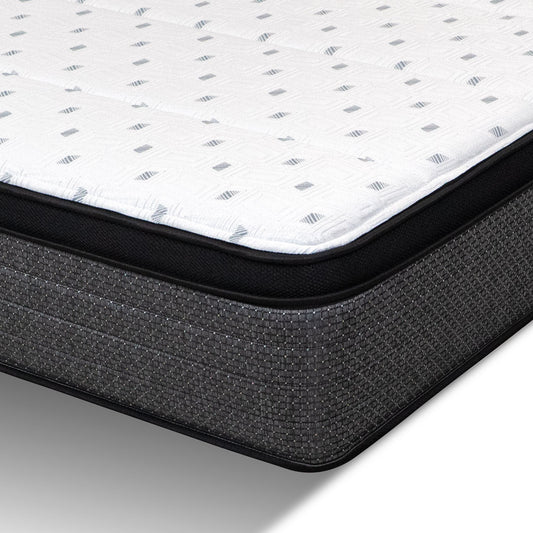
What is Far Infrared Rays technology?
The performance technology found in the ORB Performance by Off-Road Bedding is a high-tech patented coating on the mattress cover that transforms your body heat into Far Infrared Rays—reflected back to you as invisible waves of energy. Far Infrared Rays are unique in their ability to penetrate, soothe and stimulate the human body, helping you feel more energized and more well-rested.
Far Infrared Rays Technology is used in a number of industries with various applications, including:
- Performance Wear
- Apparel
- Footwear
- Mattresses
- Bedding
- Sleep Accessories
- Furniture Textiles
- Veterinary Products
What are the benefits of sleeping on a mattress with Far Infrared Rays technology?
Referred to as both “active recovery” and “smart fabric,” the ORB Performance cover utilizes Far Infrared Rays technology to harness and recycle the body’s natural energy throughout the sleep cycle. Far Infrared Rays technology is designed to help:
- Promote a temporary increase in local blood flow
- Enhance faster recovery
- Promote restful sleep
These benefits can help increase general well-being.
Does Far Infrared Rays performance technology really work?
Yes. Far Infrared Rays technology is based on the fundamental principle that heat is energy. Energy is safely and naturally transferred every day by one of three means: conduction, convection, and radiation. The transfer of energy in this case uses a thermo-reactive process to convert your body heat into Far Infrared Rays, safely recycled back into your body as energy.
Is Far Infrared Rays technology safe?
Yes. Products using Far Infrared Rays consist of a natural process that safely transfers invisible waves of energy back into your body. Far Infrared Rays are natural vasodilators, which is why the technology promotes a temporary increase in local blood flow.
Will Far Infrared Rays technology work if my skin is not in direct contact with the fabric?
Yes. The Far Infrared Rays re-emitted by the ORB's Performance any combination of sheets, blankets, mattress protectors or encasements, and sleepwear.
Will the reflection of Far Infrared Rays generate heat?
No. Far Infrared Rays will not increase the temperature of your bed.
What other factor should I consider when shopping for a mattress with responsive textiles?

Cooling Technology
The cooling properties of a mattress are critical—and based on science: a human’s actual skin temperature is 91 degrees but the ideal sleep temperature is 88 degrees.
Those in the market for a mattress should look for advanced cooling technology that, at minimum, creates a temperature neutral environment. The ORB Performance goes beyond temperature maintenance to advanced temperature moderation, infusing a state-of-the-art phase change molecule called TitanCool™ on the surface of the ORB Performance to moderate your temperature to the optimal 88 degrees.
How does it work? Cooling gel beads liquefy at higher temperatures to deliver cooling relief; those same beads solidify at lower temperatures to ensure an ideal sleep environment. An added infusion of copper also helps you sleep cooler while creating an antimicrobial sleep surface.
Personalization vs. One-Size-Fits-All
Some mattress manufacturers have adopted a one-size fits all approach, opting in most cases for a universal medium firmness. The ORB Performance is offered in three firmness levels, allowing you to better customize your sleep surface for your individual sleep needs.
All-Foam vs. Hybrid Construction
The ORB Performance offers the elite construction of a hybrid, pairing the key attributes of foam with individually encased coils. Individually encased coils deliver premium comfort and deep compression support. Because they respond independently to the contours of the human body, they provide enhanced, targeted pressure point relief. That independence also results in minimized sleep disturbance: because each coil compresses individually, motion transfer between sleep partners is greatly decreased. Individually encased coils are more durable—and they allow for greater airflow, which means a cooler, more comfortable night’s sleep.
Contouring Comfort vs. Responsiveness
Foam layers generally offer more conforming support that either reduces or eliminates pressure point pain—areas like shoulders and hips that can be sources of morning aches and pains. Foam beds contour to the curves of the body without putting too much pressure on those critical areas.
There are many different types of foam on the market. Choosing the right foam for your individual sleep needs will be important to enhancing your overall sleep experience.
- Memory Foam
Memory foam is considered a slow response foam, meaning that it may take a few seconds to return to its natural form after pressure is released. Some sleepers love that sink-ability, which gently relieves pressure points, while others are uncomfortable with what they describe as the quicksand feeling of memory foam.
- Latex Foam
Latex foam is a fast-response material that immediately returns to its shape after weight is removed—once again, some sleepers prefer that buoyancy, coupled with deep compression support, while others prefer less bounce.
- Latex Alternative Foam
While every sleeper is different, many agree that a combination of responsiveness and contouring is ideal. Latex alternative foams, like the TitanFlex™ foam used in the Spartan, bridge the gap between visco-elastic memory foam and latex. TitanFlex™ features immediate response technology that adjusts to your body each time you move, paired with just the right amount of contouring and conformability.




